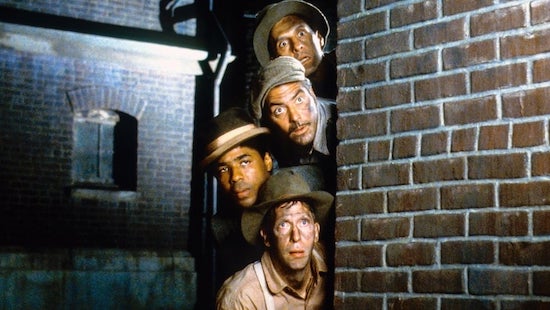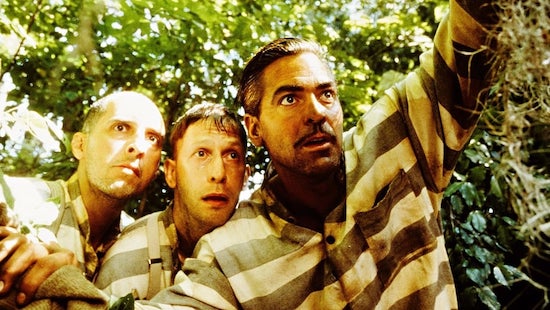The twentieth anniversary of the Coen Brothers’ O Brother, Where Art Thou? comes at a prescient time: in the wake of Black Lives Matter protests happening internationally, the American South’s constant battle over Confederate monuments in public spaces rages on. Inspired by anit-racist protesting but ultimately a product of long-term organizing, protesters in Alabama, Virginia, Georgia, and Florida have destroyed these statues of Confederacy figureheads as a part of the ongoing deconstruction of the the South’s legacy and reckoning with the region’s history of anti-Black racism that stretches back to the Reconstruction Era. As hideous monuments to the racist ideologies of the failed Confederacy, these statues themselves operate as a myth: erected decades after the war to promote the Jim Crow laws of the 1900s, they are a way to sterilize and obscur a violent past under the guise of historical preservation, while perpetuating the white supremacy at the Confederacy’s core. It is fitting, then, that the Coen Brothers’ Southern epic O Brother is structured around myths, both the overarching myth of Homer’s Odyssey and the mythic ecosystem of the American South––from the insidious, lingering lie of the Confederacy to Appalachian folklore to the tall tales in Americana songbooks. Joel and Ethan Coen’s embrace of the myth in O Brother is central to their portrayal of the South, understanding the political and cultural meaning of mythmaking and how myths are edified through visual and folk culture in a way unique to the region.
First released in 2000 with a warmly-received premiere at Cannes Film Festival, O Brother, Where Art Thou? transposes The Odyssey to Great Depression-era Mississippi, which in the hands of the Coens, music supervisor T Bone Burnett, and cinematographer Roger Deakins, is full of classic folk songs and magical realist stories of great floods, spirits, and divine intervention. In the film, three escaped convicts (George Clooney, Tim Blake Nelson, and John Turturro at their charismatic best) head out in search of treasure buried on a plot of land soon to be flooded to make a dam along the Mississippi River. In their search, they meet musicians, a fiendish Bible salesman, three sirens in a creek, a policeman (who may or may not be the Devil), and a gubernatorial candidate who moonlights as an imperial wizard of the Ku Klux Klan––all while becoming an overnight musical sensation as The Soggy Bottom Boys off of a record they cut for a quick payday on the run. It’s a fantastical romp, working best when reality is kept at bay and the quirks of the Mississippi Delta are blown up to exaggerated proportions. Their travels are illustrated through the powerful oral traditions of Americana and Gospel music that continue today. But, O Brother endures precisely because of this collage of fact, fiction, and culture. The South as it is known today (and how I, as a born-and-bred Alabamian, know it) is full of fantasies, half-true family histories, and lies. And though their analysis does fail to critically expose the anti-Black socioeconomic systems behind these stories, the Coen Brothers demonstrate that these myths are indeed complex, inextricably linked to the region’s legacies of terror, joy, and through it all, art.
At this prescient moment when some Southerners are continuing the work of unpacking the way that our folklore has shaped our entire worldview, O Brother’s embrace of myth’s paradoxical nature feels truer than ever. Take, for instance, a character by the name of Tommy Johnson, played by blues musician Chris Thomas King. Our three heroes meet Johnson at a rural crossroads, where Johnson hitches a ride in the convicts’ stolen car. When Johnson is asked why he is alone in the middle of nowhere with nothing but a guitar, he says that he traded his soul to the Devil for virtuosic musical skills. Johnson’s musical skills prove instrumental to the group’s success, or at the very least survival; as a part of the Soggy Bottom Boys, his abilities save our convicts at critical moments, including the film’s climax at a town hall. In Depression-Era Mississippi, Tommy Johnson was in fact a real-life bluesman, and, like his filmic equivalent, he also purported to have sold his soul to the Devil––a story that would more famously be attributed to other legendary guitarist Robert Johnson and many other musicians straying from gospel traditions. The real and imagined Tommy Johnson are two figures in a long line of Black blues artists whose skills were attributed to a demonic power, a tragically fitting mythos to a now-revered musical tradition that puritanical Southern white people found salacious at the turn of the century. In O Brother, this myth is acknowledged but also given depth. Alongside the Soggy Bottom Boys, Johnson plays the guitar, and in one quiet scene, he plays guitar and sings at the end of a long day. Johnson’s character is given the chance to advance as a persona and as a performer past the Devil trope, while paying tribute to the hellish legend that so many blues players across the South told. Other scenes throughout the film let these myths revel in their own complexity, while also slowly bringing out the real-life conflicts that foreground them. “Big Dan” Teague, a one-eyed Bible salesman played by Coen Brothers fixture John Goodman, is a perfect example of this Southern mythic paradox. A stand-in for The Odyssey’s cyclops, Big Dan strong-arms our travellers into taking a meeting with him about the potential profit in Bible sales, but ultimately ends up assaulting the men and taking their money. It’s a clever side-plot that uses The Odyssey’s framework to address the power that Christianity, in its most capitalistic and manipulative extremes, has in Southern culture––down to the schemes (political donations, tax evasion, etc.) preachers will use to rob believers blind.
But there are the less harmful myths, as well. The singing sirens that hypnotize our characters are straight out of the Southern roster of river monsters and critters, that have haunted sleepaway campfires and humid summer nights for decades. And, in its own creation of a meta-myth, the film’s soundtrack endures still as a contemporary companion to the Americana songbook––on folk radio, singalongs, and in the CD player in my dad’s car.

Considering the successes of the mythic appropriation of O Brother, there are moments where the whimsical nature of magic realism turns sour, especially in relation to the South’s history of systemic racism. In the film’s climax, Tommy Johnson is kidnapped to be hanged at a Klan rally. Johnson is saved by our convicts, but it is revealed that the leader of the rally is none other than one of the gubernatorial candidates, who is also holding a rally for his candidacy in the nearby town that night. Other government officials are similarly devious – such as the devilish sheriff in charge of bringing the escapees back to Parchman Prison (itself a still-operational penitentiary in Mississippi, whose cruelty and human rights abuses are memorialized in folk songs by musicians such as Bukka White, and in the stories of the Civil Rights Movement’s Freedom Riders).
In an interview with The Irish Times on the eve of the film’s release, Joel Coen categorizes the film’s politics as “frankly pretty primitive” in the way it reduces conflict down to “the bad guys [being] racial bigots and KKK Grand Dragons [while] the good guys are the heroes of the movie.” To simply dismiss the film’s politics as “primitive” is inaccurate; the politics are somewhat reductive, but the manner in which they operate upholds sinister myths in of themselves, in the way that race and myth continue to function in Southern society. The Coens address the longstanding violence at the centre of the South’s infrastructure, but only at an aesthetic level. They seemingly misunderstand how much Southern myth is wrapped up in questions of race, and how myth is instrumental in the maintenance of systemic racism still seen in Southern socioeconomic frameworks. These include the prison system (such as the aforementioned Parchman and the horrific ICE facilities in Etowah, AL), voter disenfranchisement, and ecological destruction that affects predominantly Black counties in Alabama and on Louisiana’s coast. They fail to reckon with the ways that the Confederacy––whose imagery they employ carelessly––exists because of the ways racism is passed down through family stories, perpetuating the lie that the anti-Black racism and tyranny of the Antebellum South is a heritage of which to be proud.

This hollow use of mythic structure is cemented in the film’s final act. First, the Klan candidate is rejected by his base for condemning the Soggy Bottom Boys, now one-hit wonders for their song “I Am A Man of Constant Sorrow,” for consisting of Black and white members, and then, when the sheriff out of Hell finds the Boys after the rally, a deus ex machina in the form of a flooding river once again saves our heroes from evil. The conclusion is fittingly mythic, but in its desire for a neat conclusion, the Coens’ grasp of Southern myth turns from knowingly clever to willfully ignorant. Good music and the Good Lord cannot erase centuries of white supremacy and its most abject horrors, to even suggest so is violence. The myth that art and our conscience bring us back to our better angels is patently untrue, and sanitizes the harm done not just by white supremacists, but decades upon decades of self-identified “well-meaning white people” that seek easy Kumbaya gestures instead of the righteous, uncomfortable anger required by liberation. At first blush, it could be too much to ask of a film to address this context, but context, here, is everything: the South as a setting and structure is inherently political, and so are the stories of the South in whatever form they take. Invoking the myth is invoking the past, and that is political work––or here, it is attempted political work made all the more lacking 20 years on, as Southerners continue their fight for an equitable home, actively dismantling these stories in favor of a better, kinder worldview.
The failures and triumphs of O Brother, Where Art Thou? coexist in the same way that the evils and quirks of Southern myths do: through our songs and stories, we tell the tall tales of our past, but for all of the weirdness and nostalgia in this folklore, the horrid, terrifying truth of it lies just below the surface. In their reinvention of The Odyssey, the Coens embrace the importance of folk traditions and the ways they slyly shape our societies – but they also miss the role that our folklore, art, and histories shape our future and our past in deeply violent ways. A true understanding and reckoning of Southern myth requires a full dissection of its ugly truths, and although the road forward is long, it feels sweet to know that home is creating a new South free of these myths. Constant sorrow no more.


